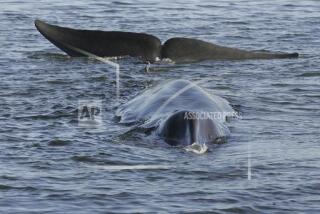Suit settled on whales and sonar
- Share via
SAN DIEGO — The Navy and several environmental groups settled a lawsuit that challenged the Navy’s use of sonar around the globe as dangerous to whales and other marine mammals, the two sides said Saturday.
Both portrayed the settlement as a victory. The case is separate from one in which the U.S. Supreme Court ruled last month that the Navy could not be unduly required to protect whales.
The Navy said the settlement -- reached Friday but announced the next day -- does not require protective measures for whales beyond those it had agreed to in 2005. Nor does it require that additional funds be spent on marine mammal research beyond the $14.75 million the Navy has already earmarked for the next three years, the Navy said.
“The settlement protects the public interest in national security by preserving the Navy’s ability to conduct realistic anti-submarine warfare training,” said Cmdr. Cappy Surette, a Navy spokesman.
A lawyer for one of the plaintiffs, the Natural Resources Defense Council, said the settlement is a victory for whales because it sets up a schedule for the Navy to implement mitigation measures and opens the training process and scientific research to civilian review.
“This does not resolve all of our disputes with the Navy, but it sets in place a process to deal with future disagreements,” said Joel Reynolds, a senior attorney and marine mammal protection specialist with the NRDC. “We’re hopeful it will lead to a much more effective dialogue.”
The litigation deals with what is called midfrequency sonar.
If the plaintiffs had been successful, the Navy said, that could have led to restrictions in some 370 training and testing activities around the world.
Under the settlement, the Navy agrees to:
* Use shipboard software to scan training areas for marine mammals and to plot a course meant to avoid sensitive areas when possible.
* Look for whales through passive sonar, lookouts and aircraft during training so that the animals can be avoided.
* Reduce or shut down sonar when whales or dolphins are spotted close to ships.
The settlement comes after the Supreme Court sided with the Navy in the similar lawsuit, which was aimed at restricting the use of sonar during exercises off Southern California and Hawaii.
Reynolds said his side had already begun negotiating with the Navy about a settlement before the Supreme Court’s decision.
Environmentalists contend that the Navy’s use of active sonar is hurting and perhaps killing whales by sending out high-pitched tones.
They say studies show the piercing underwater sounds cause whales to flee in panic or to dive too deeply.
Whales have been found beached in Greece, the Canary Islands and the Bahamas after sonar was used in the areas, and necropsies have shown signs of internal bleeding near the ears.
The Navy disputes this and says sonar training is essential for sailors to be prepared to detect super-quiet diesel submarines that are being purchased or built by rogue Third World nations, including Iran and North Korea.
In the settlement, filed before U.S. District Judge Florence-Marie Cooper in Los Angeles, the Navy agreed to pay $1.1 million in attorney fees for the case that was decided by the Supreme Court. The plaintiffs are largely the same in both cases.
In addition to the NRDC, plaintiffs were the International Fund for Animal Welfare, the Cetacean Society International, the Ocean Futures Society, the League for Coastal Protection and Jean-Michel Cousteau.
Several months before the current case was filed in 2005, the Navy, under pressure from environmental groups, submitted a plan to the National Oceanic Atmosphere Administration that was meant to limit the whales’ exposure to sonar.
In the case that went to the Supreme Court, Cooper had called the Navy’s measures inadequate.
The judge ordered the Navy to avoid using sonar within 12 miles of the coast and in areas where marine mammals congregate. She also said crews must turn off the high-intensity sonar when a marine mammal was spotted within 1.2 miles of a ship.
In January, President Bush moved to exempt the Navy from key environmental laws to override the judge’s restrictions. That led to the high court’s November decision.
--
More to Read
Sign up for Essential California
The most important California stories and recommendations in your inbox every morning.
You may occasionally receive promotional content from the Los Angeles Times.










